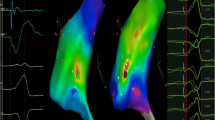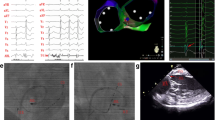Abstract
Background
Mapping of premature ventricular contractions (PVCs) originating from the right ventricular outflow tract (RVOT) sometimes is not easy because of an unstable incidence and multiple foci of the PVCs. The aim of this study was to evaluate the effectiveness of electroanatomic mapping in catheter ablation of those PVCs.
Methods and results
One hundred patients with 134 RVOT origin PVCs were randomly allotted to undergo either conventional (group I; 50 patients with 65 PVCs) or electroanatomic mapping (group II; 50 patients with 69 PVCs). In group II, electroanatomic mapping of the RVOT was performed using auto-freeze maps in patients with frequent PVCs, and pace mapping was performed marking the pacing sites on the remap which was made by extracting the anatomic frame out of the baseline map during sinus rhythm in patients with infrequent PVCs. Successful ablation was achieved in 44 (88%) group I patients and 48 (96%) group II patients (p = 0.14). The fluoroscopy and procedure times and those per PVC morphology were all significantly shorter in group II than group I overall (p < 0.0001 for all comparisons), and in each patient group with infrequent PVCs, frequent PVCs or unstable PVCs (p < 0.05–0.0001). The number of RF applications and that per PVC was significantly smaller in group II than group I (5.3 ± 1.8 vs 6.2 ± 2.4, and 4.4 ± 1.2 vs 5.2 ± 2.1; p < 0.05).
Conclusions
The use of electroanatomic mapping may reduce the fluoroscopy and procedure times in the ablation of RVOT PVCs, but there is no evidence that it improves the overall efficacy of the procedure.
Similar content being viewed by others

References
Buxton, A. E., Waxman, H. L., Marchlinski, F. E., Simson, M. B., Cassidy, D., & Josephson, M. E. (1983). Right ventricular tachycardia: Clinical and electrophysiologic characteristics. Circulation, 68, 917–927.
Morady, F., Kadish, A. H., DiCarlo, L., Kou, W. H., Winston, S., deBuitlier, M., et al. (1990). Long-term results of catheter ablation of idiopathic right ventricular tachycardia. Circulation, 82, 2093–2099.
Klein, L. S., Shih, H. T., Hackett, F. K., Zipes, D. P., & Miles, W. M. (1992). Radiofrequency catheter ablation of ventricular tachycardia in patients without structural heart disease. Circulation, 85, 1666–1674.
Coggins, D. L., Lee, R. J., Sweeney, J., Chein, W. W., Hare, G. V., Epstein, L., et al. (1994). Radiofrequency catheter ablation as a cure for idiopathic tachycardia of both left and right ventricular origin. Journal of the American College of Cardiology, 3, 1333–1341.
Gepstein, L., Hayam, G., & Ben-Haim, S. A. (1997). A novel method for non-fluoroscopic catheter-based electroanatomic mapping of the heart: In vitro and in vivo accuracy results. Circulation, 95, 1611–1622.
Dixit, S., Gerstenfeld, E. P., Callans, D. J., & Marchlinski, F. E. (2003). Electrocardiographic patterns of superior right ventricular outflow tract tachycardias: Distinguishing septal and free-wall sites of origin. Journal of Cardiovascular Electrophysiology, 14, 1–7.
Varanasi, S., Dhala, A., Blanck, Z., Deshpande, S., Akhtar, M., & Sra, J. (1999). Electroanatomic mapping for Radiofrequency ablation of cardiac arrhythmias. Journal of Cardiovascular Electrophysiology, 10, 538–544.
Khongphatthanayothin, A., Kosar, E., & Nademanee, K. (2000). Nonfluoroscopic three-dimensional mapping for arrhythmia ablation. Journal of Cardiovascular Electrophysiology, 11, 239–243.
Gerstenfeld, E., Dixit, S., Gerstenfeld, E. P., Callans, D. J., Rajawat, Y., Rho, R., et al. (2003). Quantitative comparison of spontaneous and paced 12-lead electrocardiogram during right ventricular outflow tract ventricular tachycardia. Journal of the American College of Cardiology, 41, 2046–2053.
Author information
Authors and Affiliations
Corresponding author
Rights and permissions
About this article
Cite this article
Yamada, T., Murakami, Y., Yoshida, N. et al. Efficacy of electroanatomic mapping in the catheter ablation of premature ventricular contractions originating from the right ventricular outflow tract. J Interv Card Electrophysiol 19, 187–194 (2007). https://doi.org/10.1007/s10840-007-9160-7
Received:
Accepted:
Published:
Issue Date:
DOI: https://doi.org/10.1007/s10840-007-9160-7



